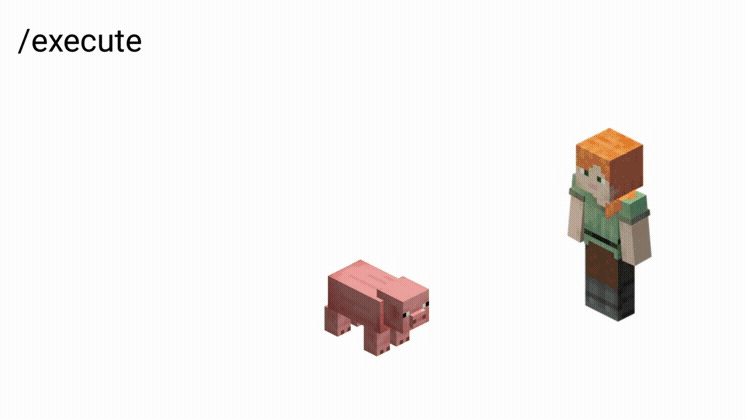Look Detection
Introduction
Sourced By Bedrock Commands Community Discord
Credits: @AjaxGb
This command-technique allows you to detect when a target looks at a player/entity/coordinate and subsequently run your desired commands.
Command
execute as <target> at @s anchored eyes facing <entity | coordinate> positioned ^^^1 positioned ~~-1.62~ rotated as @s positioned ^^^-1 if entity @s [r=0.2] run <command>
Visualisation:

Note: This is a rough visual representation, not precise measurements.
Command Breakdown:
as <target>- sets the execution target. Example:
as @p(closest player)as @e [type=zombie](all zombies)
- sets the execution target. Example:
at @s- sets the execution position to the target's feet.
anchored eyes- brings the execution position up to the target's eye level.
facing <entity | coordinate>- sets the execution rotation facing an entity or coordinate. Example:
facing 0 0 0facing coordinate: 0,0,0.facing entity @e [type=pig, c=1] eyes(facing eyes of nearest pig)facing entity @e [type=cow, r=30] feet(facing eyes of cows in a 30 block radius)facing entity @e [type=zombie] feet(facing feet of zombies)
- sets the execution rotation facing an entity or coordinate. Example:
positioned ^^^1- from previous point, pushes the execution position 1 block forward in the direction of the entity/coordinate.
positioned ~~-1.62~- lowers the execution position back to that of the player's feet on the y axis. Which is 1.62 blocks below eye level.
- Note: Due to the MCPE-165051 bug, you cannot use
anchored feetin place of this.
rotated as @s- Reverts the execution rotation to that of the target.
positioned ^^^-1- from previous point, pushes the execution position 1 block backwards from the direction the target is facing.
if entity @s [r=0.2]- checks if the target is within a 0.2 block radius from the execution position. ie., check if after this back and forth we've arrived roughly back at the target's feet position.
- To increase or decrease the tolerance for what is considered "close enough", change the
0.2distance argument.- it needs to be between
0.2and2, as2basically means you can look in the opposite direction and it's still "close enough". So, realistically, you want to most likely stay well below1.
- it needs to be between
- To calculate the exact viewing cone angle, see below.
Examples:
- Run a
/saycommand when looking at the eyes of cows or sheeps tagged 'target':
execute as @a at @s anchored eyes facing entity @e [type=cow, tag=target] eyes positioned ~~-1.62~ positioned ^^^1 rotated as @s positioned ^^^-1 if entity @s [r=0.2] run say hello cow!
execute as @a at @s anchored eyes facing entity @e [type=sheep, tag=target] eyes positioned ~~-1.62~ positioned ^^^1 rotated as @s positioned ^^^-1 if entity @s [r=0.2] run say hello sheep!
- Run a
/saycommand when looking at the position(10, 20, 30)or(6, 7, 8):
execute as @a at @s anchored eyes facing 10 20 30 positioned ~~-1.62~ positioned ^^^1 rotated as @s positioned ^^^-1 if entity @s [r=0.2] run say hello block!
execute as @a at @s anchored eyes facing 6 7 8 positioned ~~-1.62~ positioned ^^^1 rotated as @s positioned ^^^-1 if entity @s [r=0.2] run say hello block!
Alternative Structure:
execute as <target> at <coordinate | entity> facing entity @s eyes positioned as @s positioned ^^^1 rotated as @s positioned ^^^1 if entity @s[r=0.02] run <command>
If you don't need to detect the target looking at the eyes of an entity but their feet or a coordinate, you may use this structure which negates the need for the anchored eyes instruction as the execution position begins from the entity/coordinate rather than the target.
Calculate Viewing Angle
To approximate the distance/radius you want to use based on your viewing angle, you can use the following formula, where α is the angle that you want this method to trigger inside of, left and right of the target:
r = 2 * sin ( α / 2 )or, the inverse to calculate what viewing angle a certain radius / distance (r) value will give you:
α = sin^(-1) (r / 2) * 2Note: Depending on your calculator, you'll need to convert from radians to degrees.
With the above calculation, the example value of r=0.2 leaves us with roughly a 12° angle by which we can miss the exact target in either direction and still have it considered "close enough."